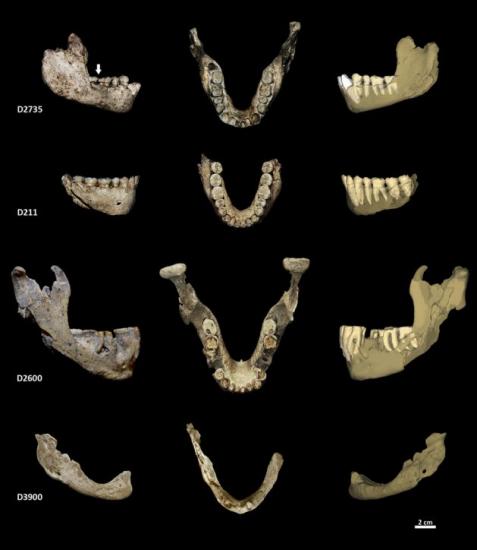Marcia Malory
Source - http://phys.org/news/2013-10-differences-hominin-jaw.html

Dmanisi mandibles. Right lateral and occlusal views are photographs taken from original specimens; left lateral views are CT-based 3D reconstructions highlighting internal structures. The canines and incisors of D2735 were found in isolation and digitally reinserted into their sockets. Arrow indicates toothpick lesion. Credit: PNAS, Published online before print October 7, 2013, doi: 10.1073/pnas.1316052110
Fossil Homo jawbones found at Dmanisi in the Republic of Georgia have different shapes. Previously, scientists were unable to explain the reason for their diversity. By comparing the Dmanisi mandibles to jawbones of modern hunter-gatherers, David Lordkipanidze of the University of Zurich and his colleagues have determined that the variation in shape could have been caused by normal wear. The research appears in the Proceedings of the National Academy of Sciences.
The oldest hominin fossils found outside Africa are 1.77 million-year-old remains found in Dmanisi between 1991 and 2005. These early Pleistocene fossils include differently-shaped jawbones. Scientists have hypothesized that the differences in shape could reflect sexual dimorphism or indicate that the fossils came from different species.
To understand the reason for the variation, Lordkipanidze and his colleagues compared the Dmanisi mandibles and mandibles from other Pleistocene fossils with those of modern hunter-gatherers. Using computed tomography and scanning electron microscopy, they examined 4 Dmanisi specimens, 5 early to mid-Pleistocene mandibles from other sites in Africa and Eurasia and 41 mandibles of modern hunter-gatherers from Greenland and Australia. All the groups studied showed variations in jaw and tooth shape that could be attributed to normal wear and tear from chewing and paramasticatory activities. According to the researchers, bite pressure, direction of bite force, the abrasiveness of food and the physiology of the periodontal ligament can contribute to tooth wear and the reshaping of the jaw over time.
One of the Dmanisi specimens had scratches on the root of a tooth and a gap between that tooth and the bone, a sign that excessive use of a toothpick had caused peritonitis. There is a substantial amount of evidence indicating that mid-to-late Pleistocene hominins used toothpicks for grooming; this is the earliest evidence of excessive toothpick use causing disease.
An individual from the Dmanisi site who had lived to an old age had lost all but one tooth before death. The researchers think it may have eaten soft food prepared with tools.
Scientists often use characteristics such as jaw height, jaw angle and tooth shape to characterize hominin mandibles and to conduct taxonomic comparisons. This research shows that different types of food, which require different forms of chewing, and different paramasticatory uses of teeth could result in substantial differences in dental wear and jaw shape among members of the same species. According to Lordkipanidze and his colleagues, further research must take this into account.
Explore further: Study reveals how enamel protects children's teeth
More information: Tooth wear and dentoalveolar remodeling are key factors of morphological variation in the Dmanisi mandibles, PNAS, Published online before print October 7, 2013, DOI: 10.1073/pnas.1316052110
Abstract
The Plio-Pleistocene hominin sample from Dmanisi (Georgia), dated to 1.77 million years ago, is unique in offering detailed insights into patterns of morphological variation within a paleodeme of early Homo. Cranial and dentoalveolar morphologies exhibit a high degree of diversity, but the causes of variation are still relatively unexplored. Here we show that wear-related dentoalveolar remodeling is one of the principal mechanisms causing mandibular shape variation in fossil Homo and in modern human hunter–gatherer populations. We identify a consistent pattern of mandibular morphological alteration, suggesting that dental wear and compensatory remodeling mechanisms remained fairly constant throughout the evolution of the genus Homo. With increasing occlusal and interproximal tooth wear, the teeth continue to erupt, the posterior dentition tends to drift in a mesial direction, and the front teeth become more upright. The resulting changes in dentognathic size and shape are substantial and need to be taken into account in comparative taxonomic analyses of isolated hominin mandibles. Our data further show that excessive tooth wear eventually leads to a breakdown of the normal remodeling mechanisms, resulting in dentognathic pathologies, tooth loss, and loss of masticatory function. Complete breakdown of dentognathic homeostasis, however, is unlikely to have limited the life span of early Homo because this effect was likely mediated by the preparation of soft foods.